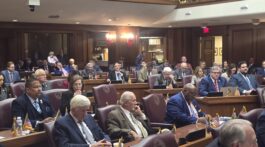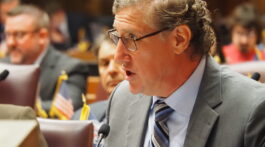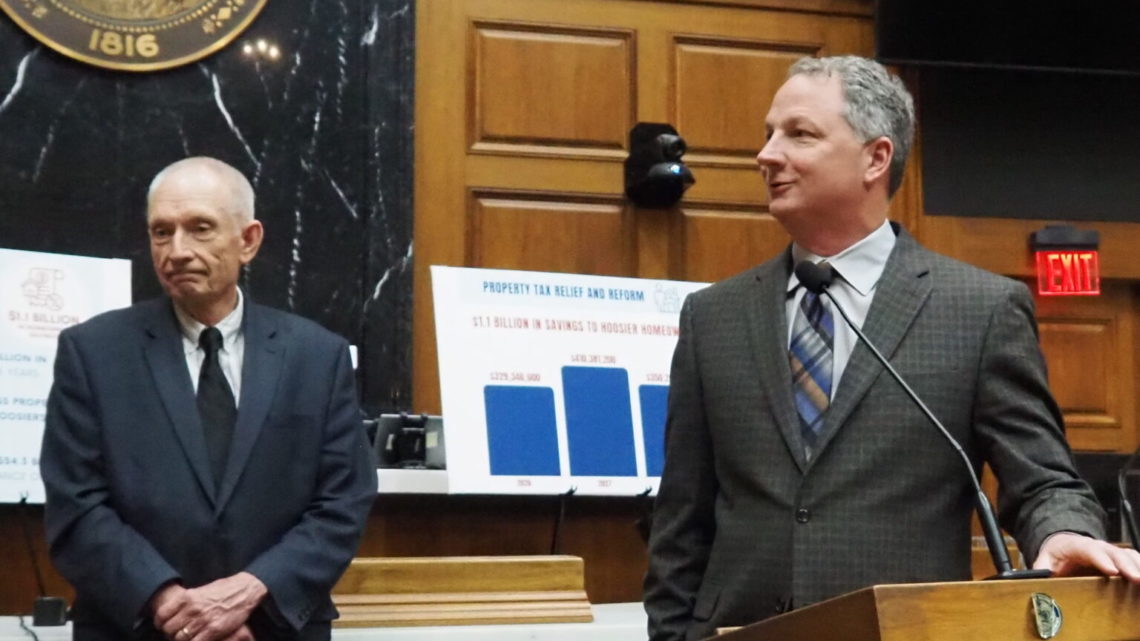by Whitney Downard, Indiana Capital Chronicle
April 4, 2025
Lawmakers introduced yet another plan for property taxes this week, pitching a proposal to save homeowners $1.1 billion over three years.
In comparison, homeowners would have seen nearly $1.3 billion in relief in 2026 alone under Gov. Mike Braun’s previous proposal.
In the atypical Friday afternoon press conference, Rep. Jeff Thompson said that 93-94% of homeowners would see lower property tax bills than they would with no action. But the majority of homeowners would pay less in 2026 than they did in 2025.
“We have two main goals in crafting this bill: deliver immediate relief to homeowners and reform the system to prevent the dramatic spikes in property taxes that we’ve seen in recent years,” said House Speaker Todd Huston. “Our amendment accomplishes both.”
The amendment to Senate Bill 1, set to be introduced on Monday, isn’t yet publicly available. Once adopted by a committee, the Legislative Services Agency will release an estimated fiscal note.
According to the two Republican leaders, all homestead property tax bills will get a 7.5% credit in perpetuity, up to $200, based on a calculation performed after accounting for property tax caps. Fixed-income seniors will see an additional $150 credit while disabled veterans will get an additional $250 credit.
“Now, every single veteran and every single senior will get a benefit if they qualify,” said Thompson, R-Lizton.
But one of the biggest benefits for the average homeowner, Huston said, would be improved transparency for taxpayers, who would be able to assess their bills on a Property Tax Transparency Portal.
“When we do a rate-based and non-levy-based system … I think the normal Hoosier homeowner can understand what their bill looks like. It’s not some algebraic equation,” said Huston, R-Fishers.
The plan for property taxes joins a handful of other efforts, including one from Gov. Mike Braun, Senate Republicans, a House Democrat and a previous Thompson pitch. Each proposal has varying impacts to homeowners and local units of government, which rely on revenue from property taxes to fund public safety, infrastructure and schools.
For instance, Braun’s plan would save homeowners the most money on their property taxes going forward but be a heavy hit to the budgets of school corporations, counties, cities and towns. Alternatively, plans that reduce that revenue loss have a small, nearly negligible impact on homeowner property taxes.
More details to come
It’s not yet clear what the total estimated impact of those credits will be to local governments. Thompson, the chief budget architect in the House, said most units will still see additional revenue but smaller increases than they would without Senate Bill 1.
“They’re still going to be gaining dollars. If I recall, it’s about a 5.6% gain (under) current law. This will roughly cut that down to a little over 3%,” Thompson said. “So they’re still adding more dollars, just not as many new dollars.”
But Huston cautioned that some units, depending on their circumstances, could see losses simply because of the “complexity of the system,” pointing to local referendums and debt.
Similarly homeowner tax bills vary significantly depending on a home’s value, the local tax rate and other factors.
“You could have the same home in the same county — and built in the same year — and you’d have two wildly different property taxes,” Huston said. “… I wish I could stand up here and give you all the bare bone specifics. I’d love to know what my property tax bill is going to look like in ‘26.”
The proposed amendment would also “rein in” locally held debt, though it’s not yet clear how the General Assembly would accomplish that. House Republicans reported that the state’s 2,000-plus local units of government hold a combined $53.4 billion in debt.
Such calculations will impact local schools, who would get a double-whammy revenue hit with the incorporation of Senate Bill 518 into the plan for property taxes. The current version would require schools to split their revenue with certain charter schools.
Under the new language for sharing property taxes, which isn’t yet available, Huston said changes for schools wouldn’t kick in until 2028 and would be phased in over four years.
Thompson also alluded to changes in the state’s personal business property tax, including a “very, very slow, gradual phase down” for purchases made after Jan. 1, 2025.
Will it be enough?
It’s uncertain whether the plan will be enough for the Hoosiers calling for relief. Last month, hundreds rallied to push lawmakers to adopt a plan closer to Braun’s proposal, pointing to tax jumps in recent years during the economic fallout of COVID-19.
Democratic Rep. Greg Porter said that big business would still be the winners in a Friday press release, criticizing the plan for not addressing home assessments that increase faster than business assessments.
He also denounced the lack of relief for renters as well as an increased reliance on local income taxes for municipalities to backfill losses.
“Our schools will lose money, especially with Senate Bill 518 rolled into the plan diverting property tax dollars to charter schools so the state can pay even less. This plan encourages local governments to raise their local income tax rate, so you’ll get more money in your right pocket but have to pay more out of your left,” Porter continued.
Braun threatened to veto earlier versions of the proposal, citing the need for homeowner relief. Still, Huston seemed comfortable with the current package.
“We feel very good about the trajectory that we’re on and we will continue to work with our partners on this and figure out where the best place to land the plane is,” said Huston.











